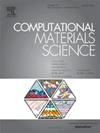合金元素Cr、Ni、Ti掺杂对TiC/Fe界面性能影响的机理研究
IF 3.3
3区 材料科学
Q2 MATERIALS SCIENCE, MULTIDISCIPLINARY
引用次数: 0
摘要
TiC/γ-Fe界面结合失效已成为制约复合材料性能提高的关键瓶颈。通过第一性原理计算研究了掺杂和清洁界面的形成能、界面粘附功、电子性质和d带中心。结果表明,在TiC/γ-Fe界面处,ti掺杂的形成能最低(- 0.15 eV),表现出最高的稳定性。界面粘接功为:掺铬界面(6.53 J/m2) >;掺钛(6.39 J/m2) >;ni掺杂(5.15 J/m2),表明Cr和Ti掺杂显著增强了界面结合强度。电子结构分析表明,Cr-C键以共价键为主。Cr的掺入增强了界面处Fe-C键的结合强度。,而Cr和ti掺杂的界面都表现出比清洁系统更明显的电荷转移,从而增强了界面键合的强度。d带中心与粘接功之间存在显著的正相关关系,表明表面d带中心的变化为增强界面粘接强度提供了有效途径。计算结果阐明了Cr和Ti掺杂增强TiC/γ-Fe界面结合强度的基本机理,为复合材料界面性能的研究提供了理论指导和有效的调制策略。本文章由计算机程序翻译,如有差异,请以英文原文为准。

Mechanistic investigation of alloying elements Cr, Ni, Ti doping effects on TiC/Fe interfacial properties
The interfacial bonding failure of TiC/γ-Fe has emerged as a critical bottleneck restricting the performance enhancement of composite materials. The formation energy, interfacial adhesion work, electronic properties, and d-band center of both doped and clean interfaces were investigated by first-principles calculations. The results show that the Ti-doped interface exhibits the highest stability, attributed to its lowest formation energy (−0.15 eV) at the TiC/γ-Fe interface. The interfacial adhesive work follows the order: Cr-doped interface (6.53 J/m2) > Ti-doped (6.39 J/m2) > Ni-doped (5.15 J/m2), revealing that the interfacial bonding strength was significantly enhanced by Cr and Ti doping. Electronic structure analysis reveals that Cr-C bond exhibit predominantly covalent characteristics. The bonding strength of the Fe-C bond at the interface was enhanced by Cr doping., while both Cr- and Ti-doped interfaces demonstrate more pronounced charge transfer compared to clean systems, thereby strength of interfacial bonding was enhanced. A significant positive correlation was identified between the d-band center and adhesive work, suggesting that the change of surface d-band center provides an effective pathway to enhance strength of interfacial bonding. The computational results elucidate the fundamental mechanisms the whereby interfacial bonding strength of TiC/γ-Fe was enhanced by Cr and Ti doping, offering both theoretical guidance and effective modulation strategies for researches the interfacial performance of composite materials.
求助全文
通过发布文献求助,成功后即可免费获取论文全文。
去求助
来源期刊

Computational Materials Science
工程技术-材料科学:综合
CiteScore
6.50
自引率
6.10%
发文量
665
审稿时长
26 days
期刊介绍:
The goal of Computational Materials Science is to report on results that provide new or unique insights into, or significantly expand our understanding of, the properties of materials or phenomena associated with their design, synthesis, processing, characterization, and utilization. To be relevant to the journal, the results should be applied or applicable to specific material systems that are discussed within the submission.
 求助内容:
求助内容: 应助结果提醒方式:
应助结果提醒方式:


